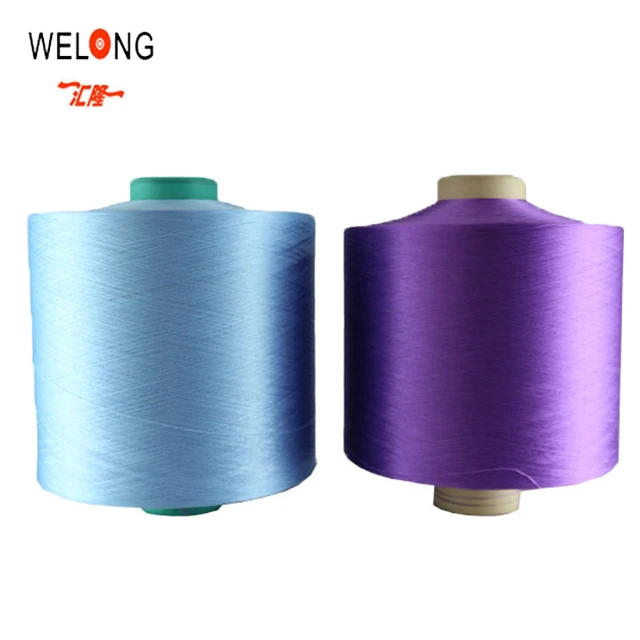Another cloth from sustainable fabrics category is 150D GRS DTY recycled polyester textured yarn. This is very nice yarn, because it helps the earth and you get great fabrics! Inside canteen; under florescent lights Work Made from recycled beverage bottles: fantastic as utilizes up to 20 old water or soda bottles! If Your Passioncare a litral on our jung environment then this yarn is asuperbrient choice from recyclable perspective.
So boring things, let us explore in this eco-material world interesting 150D GRS DTY Recycled Polyester Yarn. It revolutionized textiles and the influence of it is seen throughout the textile industry in its ability to be sustainable but also masterfully produced as a high-performance fabric. This yarn is truly revolutionizing what we thought of synthetic fibers when it comes to fashion, this one-of-a-kind thread uses old plastic bottles (mainly a recycled PET-material) and gives in turn new life. The 150D GRS DTY yarn emerges as a sustainable alternative showing that hope for performance and versatility is attainable among designers/brandsritaising the sortiment supporting purchases made with reclaimed materials reaching their circular economy aim.
Finding the Charms of Yarn
This type of polyester blend is more about long term sustainability in the production of textiles - and this new yarn base has proven to be an exciting way to replicate that solution for textile lovers who are eco-conscious. Aside from that, this yarn is one of the most sustainably produced in their collection above all else it will say so), as its origins are GRS Certified (Global Recycled Standard). This certification ensures that the yarn has been independently certified as containing at least 50% recycled materialwhich contains no azo dyes and harmful chemicals, complies with specific testing criteria for over one hundred hazardous substances including lead, arsenic... through each stage of production. In addition to reducing the dependency on new polyester, it helps reduce pollution from plastics disposal. Also, recycled polyester requires less water and energy during production as compared to virgin means hence save the air pollution factors.
Ways to Use the Yarn
The fabric made by the DTY (Drawn Textured Yarn) formula exhibits unique textural appearance, incorporated with high bulky material and good stretch & recovery characteristics. Check out more on this 150D GRS DTY yarn here----->>> What Makes This All-Rounder In All Types Of Fabrics")!=0){googletag.cmd. Tactile auxiliaries, of courseHyosung These versatile yarns can be used in anything from rugged sportswear which necessitates the exercise and luxury.Our to fine touchNeeded home textiles that require softness. And so sustainable fashion is just another textiles product only in a different specialty which can be produced if appropriate.
How is RPET Fabric Made?
A journey on which 150D recycled polyester yarn is transformed into RPET (Recycled Polyethylene Terephthalate) fabric showcasing the principles of circular economy in action. Post-consumer plastics are collected and sorted, then cleaned by removing contaminants before being melted down to form pellets which can be used in a yarn spinning operation. A 150 denier high-strength exoskeletal memory yarn to enable weaving or knitting of robust/durable/performance RPET fabrics. Avert_Cat created some unique and sustainable sourced fabric which is environmentally responsible, as well are high quality-driven to serve your values a priority while also taking the highest viable shape for being accessible alternative on the sustainability side.
Related: 3D printed solar textiles could mean sunny days for your next charge-devouring pillow
Get to know the revolutionary feature of a 150D GRS DTY yarn that re-writes industry standards and enables textile's step into eco-conscious innovation. This yarn aims not only to disrupt the status quo of manufacturing with a sustainable alternative that performs just as well if not better, but it is also encouraging more eco-friendly practices from sourcing all the way up through production. This is driving brands towards more sustainable supply chains requiring transparency and traceability for every stage of production to achieve GRS certification. In response to rising consumer demand for environmental goods it also describes a wider industry transition away from virgin plastics and towards recycled or reused material.
Realizing The Benefits Of 150D DTY Recycled Polyester
In this post, we will be talking about how 150D DTY recycled polyester improves upon all the qualities that make RPET so great. This results in a feature of improved print fastness and stronger cloth, thus have less frequently to replace them due longevity properties. Good printability and dyeabiltty are also a positive feature allowing vibrant designs to be created as required along with various offerings of aesthetics according the modern fashion trends. Their lightweight durability means they are attractive for new applications as well, in products like breathable activewear or high-tech weather-proof outerwear. Brands can answer that call with 150D DTY Recycled Polyester, this allows brands to still offer the premium products consumers have come to expect while doing so through a more eco-friendly lens.
Most proper meaning in today s language, 150D GRS DTY recycled polyester textured yarn are clearly> forCellReuseIdentifier:bio_based Textiles has a new Yarn Core!. The company sustainability has inculcated from culture to culture throughout the upcoming future promising a fashion and conservation hand to hand held tale because of its eco-friendly factor as it can b be used versatile when tenders provide-up manufacturing out waste premium RPET (Recycle Polyethylene Terephthalate) fabrics together they are contributing towards re-defining ways of fabric industries standard by providing other lot benefits too for high quality production. And as much as we want to discover and celebrate these breakthroughs, they also represent huge steps towards saving our planet while opening brand new possibilities for both the aesthetic & functionality consideration of textiles.

 EN
EN
 AR
AR
 PT
PT
 RU
RU
 ES
ES
 ID
ID
 VI
VI
999999/images/share.png)
